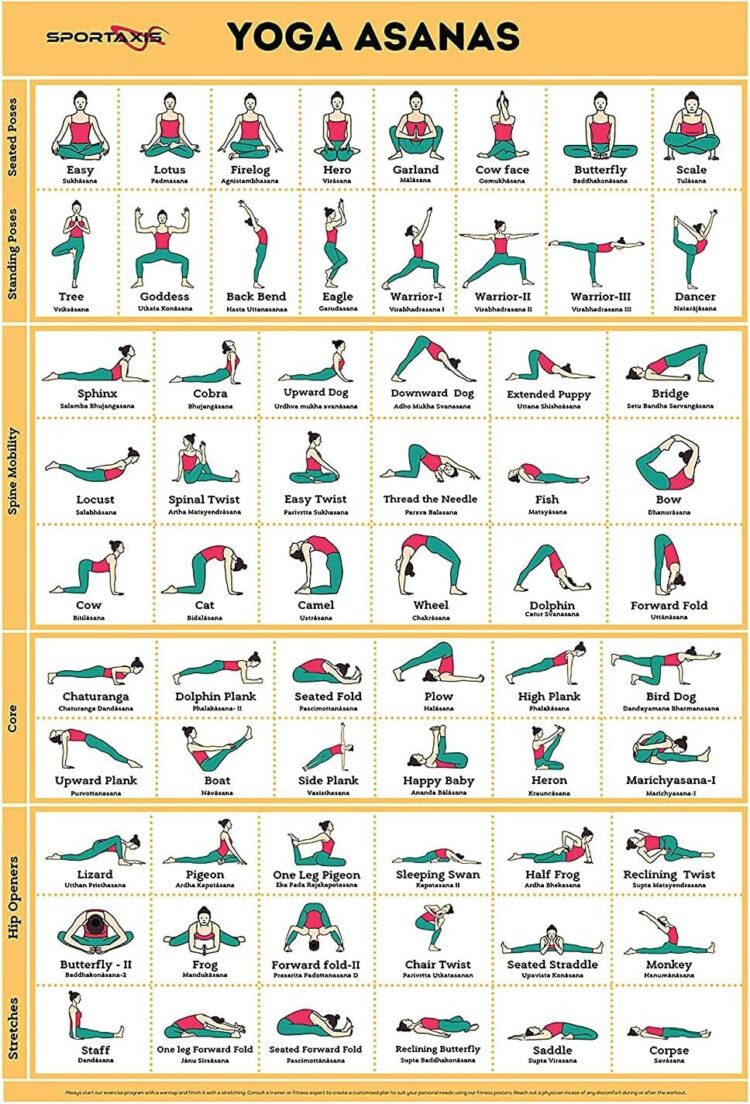Yoga Poses for Allergy Relief
 Allergies are a common issue that many people face, especially during the change of seasons when pollen counts rise, and various allergens are in abundance. According to the Asthma and Allergy Foundation of America, more than 50 million Americans experience different types of allergies annually. While conventional treatments like antihistamines and nasal sprays are widely used, yoga offers a natural, holistic approach to managing allergy symptoms. This article will explore specific yoga poses that can provide relief from allergies and improve your overall health and well-being.
Allergies are a common issue that many people face, especially during the change of seasons when pollen counts rise, and various allergens are in abundance. According to the Asthma and Allergy Foundation of America, more than 50 million Americans experience different types of allergies annually. While conventional treatments like antihistamines and nasal sprays are widely used, yoga offers a natural, holistic approach to managing allergy symptoms. This article will explore specific yoga poses that can provide relief from allergies and improve your overall health and well-being.
Understanding Allergies and Their Impact
Allergies occur when the immune system overreacts to substances such as pollen, dust, mold, or pet dander. These substances, known as allergens, can cause a variety of symptoms, including sneezing, itching, nasal congestion, and watery eyes. In some cases, allergies can lead to more severe respiratory issues, such as asthma or sinus infections.
The Prevalence of Allergies
– Over 30% of adults and 40% of children in the U.S. are affected by allergies.
– Allergic rhinitis, also known as hay fever, affects approximately 20 million adults and 6 million children annually.
– Allergies can lead to significant economic burdens, with $18 billion spent annually on healthcare costs related to allergies in the U.S.
The Impact of Allergies on Quality of Life
Allergies can have a profound impact on an individual’s quality of life. They can lead to fatigue, difficulty concentrating, and disrupted sleep, which can affect work or school performance. Additionally, allergies can exacerbate other health conditions, such as asthma or eczema, further affecting overall health and well-being.
Yoga for Allergy Relief: The Science Behind It
Yoga is an ancient practice that combines physical postures, breathing exercises, and meditation to promote physical, mental, and emotional well-being. Research has shown that yoga can manage various health conditions, including allergies.
How Yoga Helps Alleviate Allergies
1. Improved Breathing: Yoga emphasizes deep, controlled breathing, which can help expand lung capacity and improve respiratory function. This can lead to better oxygen exchange and reduce the severity of allergy symptoms.
2. Reduced Stress: Stress can weaken the immune system and exacerbate allergy symptoms. Yoga promotes relaxation and reduces stress levels, which can enhance the body’s ability to cope with allergens.
3. Enhanced Immune Function: Regular yoga practice boosts circulation and stimulates the lymphatic system, which plays a crucial role in maintaining a healthy immune response. This can help the body fight off allergens more effectively.
4. Mind-Body Connection: Yoga encourages mindfulness and self-awareness, helping individuals recognize and manage triggers that may worsen their allergies. This heightened awareness can lead to better self-care and management of symptoms.
Scientific Evidence Supporting Yoga for Allergies
– A study published in the journal BMC Complementary and Alternative Medicine found that yoga significantly reduced symptoms of allergic rhinitis, including nasal congestion and sneezing.
– Research in the International Journal of Yoga showed that yoga improved respiratory function and reduced stress in individuals with asthma and allergies.
– A study from Korea Science indicates that a six-week yoga regimen significantly reduces symptoms of allergic rhinitis and improves the quality of life for sufferers.
🧘♂️Transform Your Yoga Practice Today! Conquer Allergies!🧘♀️
 Effective Yoga Poses for Allergy Relief
Effective Yoga Poses for Allergy Relief
Incorporating specific yoga poses into your routine can help alleviate allergy symptoms and enhance your overall health. Here are some effective poses to try:
1. Bridge Pose (Setu Bandhasana)
The Bridge Pose is excellent for opening up the chest and improving lung capacity, making it easier to breathe during allergy season. This pose stretches the neck, spine, and chest, allowing for better airflow and clearing the nasal passages. Additionally, it promotes relaxation and can reduce stress, which may exacerbate allergy symptoms.
How to do it:
– Lie on your back with your knees bent and feet hip-width apart.
– Place your arms alongside your body with palms facing down.
– Press your feet into the mat and lift your hips toward the ceiling.
– Hold the pose for 30 seconds to 1 minute, focusing on deep breathing.
2. Fish Pose (Matsyasana)
Fish Pose is known for its ability to relieve congestion and open up the throat and lungs. By stretching the upper body, it aids in improving respiratory function and reducing sinus pressure. This pose also stimulates the thymus gland, which plays a role in immune function.
How to do it:
– Lie on your back with your legs extended and arms by your sides.
– Slide your hands under your hips, palms down, and lift your chest.
– Arch your back and gently rest the crown of your head on the mat.
– Hold for 30 seconds, breathing deeply to maximize the stretch.
3. Plow Pose (Halasana)
The Plow Pose is effective for calming the mind and relieving tension, which can help reduce stress-induced allergic reactions. This pose improves blood circulation to the head and sinuses and relieves nasal congestion and headaches associated with allergies.
How to do it:
– Lie on your back with your arms at your sides.
– Lift your legs over your head, bringing your toes toward the floor behind you.
– Keep your hands on your back for support, or place them flat on the mat.
– Hold for 1 to 2 minutes, breathing deeply and allowing the stretch to open your airways.
4. Downward-Facing Dog (Adho Mukha Svanasana)
Downward-Facing Dog is a staple yoga practice and is particularly beneficial for allergy relief. This pose helps drain mucus from the sinuses, improves circulation, and reduces stress. It also strengthens the immune system by increasing blood flow to the head.
How to do it:
– Start on your hands and knees in a tabletop position.
– Lift your hips up and back, straightening your legs and forming an inverted V-shape.
– Keep your head between your arms, and press your heels toward the ground.
– Hold the pose for 1 minute, focusing on steady and controlled breathing.
5. Shoulder Stand (Sarvangasana)
The Shoulder Stand is known as the “queen of all asanas” due to its numerous benefits, including allergy relief. This inversion pose helps drain lymphatic fluid and clear nasal passages, making breathing easier. It also enhances immune function and provides a calming effect on the mind.
How to do it:
– Lie on your back with your legs together and arms at your sides.
– Lift your legs and hips toward the ceiling, supporting your lower back with your hands.
– Keep your legs straight and aligned with your body.
– Hold the pose for 30 seconds to 1 minute, focusing on deep inhalations and exhalations.

Yoga Seasonal Allergies: A Natural Remedy
Seasonal allergies, often known as hay fever or allergic rhinitis, can be incredibly disruptive, causing symptoms like sneezing, itchy eyes, and congestion. While over-the-counter medications can provide temporary relief, yoga offers a natural and holistic way to combat these symptoms and strengthen your body’s response to allergens. Here’s how yoga can help with seasonal allergies:
1. Clearing Sinuses and Improving Breathing
Certain yoga poses, particularly inversions like Downward-Facing Dog and Shoulder Stand, can help clear the sinuses by promoting mucus drainage and improving circulation to the head. Controlled breathing exercises, known as pranayama, are also crucial in yoga practice for seasonal allergies. Pranayama techniques like Nadi Shodhana (Alternate Nostril Breathing) and Ujjayi (Victorious Breath) help to calm the nervous system, reduce stress, and open up nasal passages. This improves respiratory function, making breathing easier even when allergens peak.
2. Reducing Inflammation
Yoga has been shown to reduce inflammation in the body, which is often at the root of allergy symptoms. By practicing yoga regularly, individuals can lower levels of inflammation markers, such as C-reactive protein (CRP), which are often elevated during allergic reactions. This reduction in inflammation can lead to fewer symptoms and less discomfort during allergy season.
3. Enhancing Immune Function
Regular yoga practice boosts the immune system, making it more resilient against allergens. A stronger immune system can respond more effectively to allergens, reducing the severity of allergic reactions. Inversions and poses that stimulate the lymphatic system, such as the Plow Pose and Bridge Pose, are particularly beneficial in enhancing immune function.
4. Promoting Relaxation and Stress Relief
Stress can exacerbate allergy symptoms by weakening the immune system and increasing inflammation. Yoga promotes relaxation and reduces stress levels, which can help alleviate allergy symptoms. By incorporating mindfulness and meditation into yoga practice, individuals can achieve a more profound sense of calm and relaxation, reducing the impact of allergies on daily life.
5. Encouraging Mindful Living
Yoga encourages mindfulness and self-awareness, which can help individuals recognize and manage triggers that may worsen their allergies. By becoming more aware of environmental factors and lifestyle habits that contribute to allergies, individuals can make informed decisions to reduce exposure and minimize symptoms. Mindfulness practices can also help individuals develop healthier habits, such as better sleep hygiene and nutritional choices, further supporting overall health and well-being during allergy season.
Additional Benefits of Yoga for Allergy Sufferers
In addition to specific poses for allergy relief, practicing yoga regularly offers a range of benefits for overall health and well-being. Here are some additional benefits of yoga for allergy sufferers:
1. Improved Sleep
2. Enhanced Lung Function
3. Increased Energy Levels
4. Detoxification
5. Emotional Well-being
Breathe Easy and Flow Freely: Upgrade Your Yoga Experience with Premium Gear That Beats Allergies!
Conclusion:
Yoga offers a natural, holistic approach to managing allergies and improving overall health and well-being. By incorporating specific poses and breathing exercises into your routine, you can alleviate common allergy symptoms, reduce stress, and strengthen your body’s resilience against allergens. Whether you’re new to yoga or a seasoned practitioner, integrating these poses into your practice can provide significant relief and enhance your quality of life.
As you embark on your yoga journey for allergy relief, remember to consult with a healthcare professional, especially if you have existing health concerns. Embrace the benefits of yoga and experience the transformative power it can have on your physical and emotional well-being, helping you live a healthier, more balanced life free from the burden of allergies.
References:

